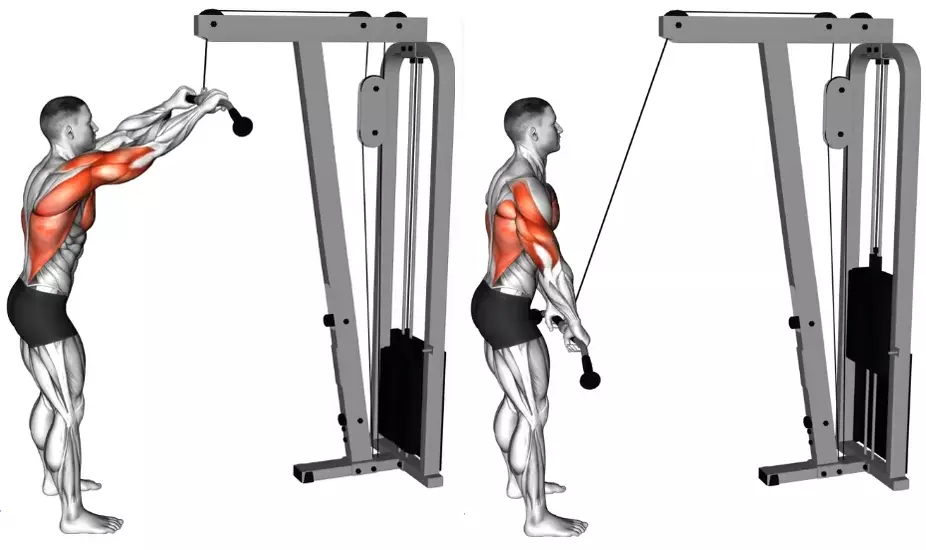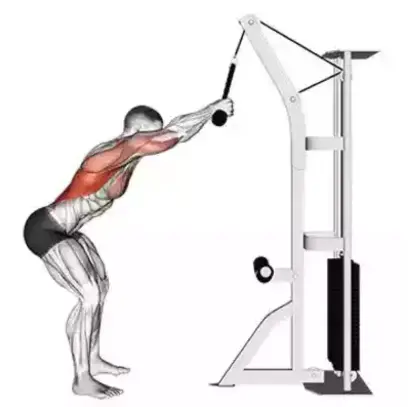Introducing the best lat pushdown variations offers an exciting opportunity to diversify and enhance your back workout routine. Each variation targets the latissimus dorsi muscles from different angles, providing a comprehensive approach to strengthening and defining your back. Whether you’re aiming to improve muscle size, enhance muscular endurance, or refine your overall back aesthetics, these variations offer versatility and effectiveness. From standard lat pushdowns to reverse grip and single-arm variations, including these exercises into your routine can take your back training to the next level.
What is Lat Pushdown?
Lat pushdown is a strength training exercise primarily targeting the latissimus dorsi muscles, located in the back. It involves using a cable machine with a high pulley and a bar or handle attachment. During the exercise, the individual stands facing the cable machine, grips the bar or handle, and pushes it downwards while keeping the elbows close to the body. This movement engages the lats, helping to strengthen and define the back muscles. Lat pushdowns are commonly included in upper body workout routines to promote muscle growth and improve overall back strength.

Benefits of Lat Pushdown
The benefits of lat pushdowns are many and contribute to overall strength, muscle development, and fitness. Here are some key benefits:
- Strengthening the Latissimus Dorsi: Lat pushdowns primarily target the latissimus dorsi muscles, which are the largest muscles in the back. By regularly performing lat pushdowns, you can strengthen and develop these muscles, leading to improved posture, stability, and functional strength.
- Improved Muscle Definition: Including pushdowns into your workout routine can help sculpt and define the muscles of the back, including the lats, rhomboids, and rear deltoids. This can contribute to a more aesthetically pleasing physique and enhanced muscle definition.
- Reduced Risk of Injury: Strong and well-developed back muscles are important for maintaining proper spinal alignment and supporting the spine during everyday movements and exercise. By strengthening the muscles targeted in lat pushdowns, you can reduce the risk of back injuries and improve overall spinal health.
- Enhanced Upper Body Strength: Lat pushdowns not only target the back muscles but also engage the muscles of the arms, including the triceps and biceps. As a result, including lat pushdowns into your workout routine can contribute to increased upper body strength and functional fitness.
- Versatility and Accessibility: Lat pushdowns can be performed using different equipment, including cable machines, resistance bands, or even bodyweight exercises. This versatility makes lat pushdowns accessible to individuals of all fitness levels and allows for customization based on individual goals and preferences.
Overall, including lat pushdowns into your workout routine can give many benefits, including improved back strength, muscle definition, injury prevention, and upper body strength development. By performing pushdowns with proper form and technique, you can optimize your results and maximize the benefits of this effective exercise.

Lat Pushdown Variations
Standard Lat Pushdown
- Standard lat pushdown are the foundation of any back workout.
- To perform this variation, attach a straight bar to the high pulley of a cable machine.
- Stand facing the machine with feet shoulder-width apart, and grasp the bar with an overhand grip, slightly wider than shoulder-width.
- Keeping your elbows close to your body, push the bar down until your arms are fully extended, then slowly return to the starting position.
Reverse Grip Lat Pushdown
- Reverse grip lat pushdown shifts the focus onto the lower portion of the lats and also engages the biceps to a greater extent.
- Begin by attaching a straight or EZ-curl bar to the high pulley.
- This time, grip the bar with your palms facing up (underhand grip), about shoulder-width apart.
- Keeping your elbows tucked in, push the bar down until your arms are fully extended, then return to the starting position with control.
Rope Lat Pushdown
- Rope lat pushdown provides a greater range of motion and allows for a stronger contraction at the bottom of the movement.
- Attach a rope handle to the high pulley and grasp each end with an overhand grip.
- With your elbows at your sides, push the rope down towards your thighs, fully extending your arms, then slowly release back to the starting position.
Single Arm Lat Pushdown
- Single arm lat pushdown helps to correct muscle imbalances between the left and right sides of the back while also improving stability and core strength.
- Attach a single handle to the high pulley and stand facing the machine.
- Grasp the handle with one hand, keeping your elbow close to your side.
- Push the handle down and across your body, fully extending your arm, then return to the starting position.
Close Grip Lat Pushdown
- Close grip lat pushdown targets the outer portion of the lats and also engages the triceps muscles to a greater degree.
- Attach a straight bar to the high pulley and grasp it with a close grip, hands positioned about six inches apart.
- Keeping your elbows tucked in, push the bar down until your arms are fully extended, then slowly release back up.
Tips for Maximizing Effectiveness
To maximize the effectiveness of your lat pushdown workouts, consider the following tips:
- Focus on Form: Proper form is essential for targeting the right muscles and preventing injury. Keep your back straight, shoulders down and back, and elbows close to your sides throughout the movement.
- Control the Movement: Avoid using momentum to lift the weight. Instead, focus on controlling the movement both on the way down and on the way up. This ensures that your muscles are doing the work, not gravity.
- Mind-Muscle Connection: Concentrate on engaging your lat muscles during each repetition. Visualize them contracting as you push the weight down, and focus on the sensation of the muscles working.
- Full Range of Motion: Aim to fully extend your arms at the bottom of each repetition and fully contract your lats at the top. This ensures that you’re getting the most out of each rep and maximizing muscle activation.
- Adjust the Weight: Choose a weight that allows you to complete each set with proper form while still feeling challenged.
- Variety is Key: Include different lat pushdown variations into your workouts to target your muscles from different angles and keep your routine fresh. Experiment with different grips, attachments, and hand positions to challenge your muscles in new ways.
- Mind Your Breathing: Exhale as you push the weight down and inhale as you return to the starting position. This helps stabilize your core and maintain proper form throughout the movement.
- Include Lat Activation Exercises: Before starting your pushdowns, include exercises that activate and warm up your lat muscles, such as pull-ups, lat pulldowns, or straight-arm pulldowns. This primes your muscles for the work ahead and helps prevent injury.
- Progressive Overload: Continuously challenge your muscles by gradually increasing the weight, reps, or sets over time. This progressive overload stimulates muscle growth and strength gains.
- Rest and Recovery: Allow your muscles adequate time to rest and recover between workouts. Aim for at least 48 hours of rest before targeting the same muscle group again to prevent overtraining and promote muscle growth.
By following these tips, you can maximize the effectiveness of your lat pushdown workouts and achieve better results in terms of muscle growth, strength, and overall fitness.

Common Mistakes to Avoid
When performing lat pushdown exercises, it’s important to avoid common mistakes that can compromise your form, reduce effectiveness, and increase the risk of injury. Here are some mistakes to clear:
- Using Too Much Weight: One of the most common mistakes is using excessive weight, which often leads to swinging or jerking motions. This not only reduces the effectiveness of the exercise but also increases the risk of injury to the shoulders, elbows, and back. Choose a weight that allows you to maintain proper form and control throughout the movement.
- Leaning Back: Leaning back or arching your lower back excessively during pushdowns shifts the focus away from the targeted muscles and places undue stress on the spine. Maintain a stable and upright posture throughout the exercise to keep tension on the lats and minimize strain on the lower back.
- Using Momentum: Using momentum to lift the weight rather than relying on your muscles reduces the effectiveness of the exercise and increases the risk of injury. Avoid swinging or jerking the weight and focus on controlled movements to fully engage the lats and surrounding muscles.
- Incorrect Grip or Hand Position: Using an incorrect grip or hand position can alter the mechanics of the exercise and shift the emphasis to different muscle groups. Ensure that your grip is comfortable and that your hands are positioned appropriately on the bar or handle to target the lats effectively.
- Rounding the Shoulders: Allowing the shoulders to round forward or shrug up towards the ears during lat pushdowns can compromise the stability of the shoulder joints and limit the range of motion. Keep your shoulders down and back throughout the exercise to maintain proper alignment and maximize muscle engagement.
- Neglecting Core Stability: Failing to engage your core muscles during lat pushdowns can lead to poor posture and instability, increasing the risk of injury. Keep your core muscles braced throughout the exercise to stabilize your spine and maintain proper form.
- Overarching the Lower Back: Arching your lower back excessively at the bottom of the movement can strain the lumbar spine and lead to discomfort or injury. Maintain a neutral spine position by gently bracing your core and avoiding excessive arching.
By avoiding these common mistakes and focusing on proper form and technique, you can maximize the effectiveness of your lat pushdown workouts while minimizing the risk of injury.
Conclusion
In conclusion, including the five best lat pushdown variations into your workout routine can significantly benefit your back training efforts. By targeting different angles of the latissimus dorsi muscles and providing versatility in your exercises, these variations offer a comprehensive approach to achieving a stronger, more defined back. Whether you’re a beginner or an experienced lifter, adding these variations can help you maximize muscle growth, improve strength, and improve overall back aesthetics for a well-rounded physique.
FAQs
Q. How many sets and reps should I do for each lat pushdown variation?
Aim for 3-4 sets of 8-12 reps for each variation to promote muscle growth and strength development.
Q. Can beginners perform these lat pushdown variations?
Yes, beginners can start with lighter weights and focus on mastering proper form before progressing to heavier loads.
Q. Are lat pushdowns suitable for individuals with back injuries?
It’s essential to consult with a healthcare professional before performing lat pushdowns or any exercise if you have a history of back injuries. Start with light weights and gradually increase intensity under supervision.
Q. Should I perform lat pushdowns at the beginning or end of my workout?
They can be performed at any point during your workout, but it’s recommended to prioritize compound exercises such as rows and pull-ups before isolation exercises like lat pushdowns.
Q. Can I do lat pushdowns with resistance bands if I don’t have access to a cable machine?
Yes, you can replicate lat pushdowns using resistance bands anchored to a sturdy object. Adjust the band’s resistance to match your fitness level and perform the exercise with proper form.

